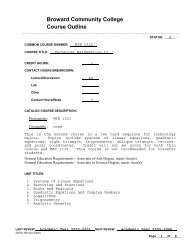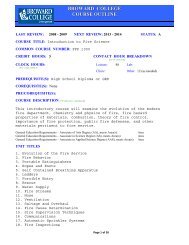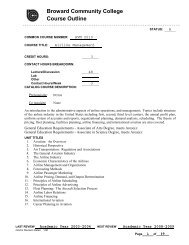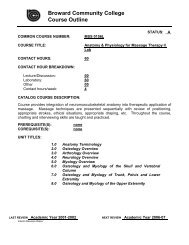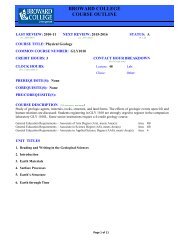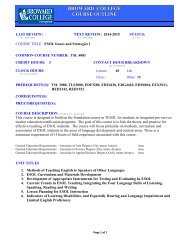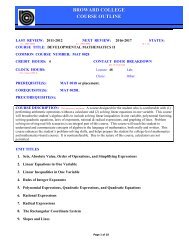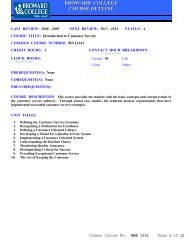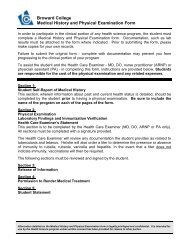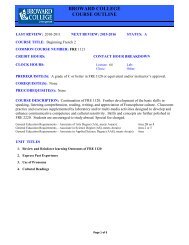AML2600 - Broward College
AML2600 - Broward College
AML2600 - Broward College
- No tags were found...
Create successful ePaper yourself
Turn your PDF publications into a flip-book with our unique Google optimized e-Paper software.
BROWARD COLLEGECOURSE OUTLINELAST REVIEW: 2010-2011 NEXT REVIEW: 2015-2016 STATUS: A(i.e. 2006-2007) (i.e. 2011-2012) (A, I, D)COURSE TITLE: African American LiteratureCOMMON COURSE NUMBER: AML 2600CREDIT HOURS: 3CONTACT HOUR BREAKDOWN(Per 16 week term)CLOCK HOURS: Lecture: 48 Lab:(Voc. Course ONLY)Clinic:Other:PREREQUISITE(S): Eligibility for ENC 1101COREQUISITE(S): NonePRE/COREQUISITE(S): NoneCOURSE DESCRIPTION (750 characters, maximum):Students will be introduced to works that represent diverse African American literature since 1746. Textsmay be selected from major authors such as Angelou, Douglass, Hughes, Hurston, King, and Truth. Uponsuccessful completion of the course, students will understand the significant concepts, contexts, movements,figures, and works of African American literature since 1746. A student must earn a grade of “C” orhigher to meet the requirements of the Gordon rule.General Education Requirements – Associate of Arts Degree (AA), meets Area(s):Area 2AGeneral Education Requirements – Associate in Science Degree (AS), meets Area(s): Area 2General Education Requirements – Associate in Applied Science Degree (AAS), meets Area(s): Area 2UNIT TITLES1. Introduction to the Study of African American Literature2. African American Literature from 1746 to 18653. African American Literature from 1865 to 19404. African American Literature from 1940 to the present5. Writing about African American LiteraturePage 1 of 9
BROWARD COLLEGECOURSE OUTLINE*** Complete the following only if course is seeking general education status ***GENERAL EDUCATION Competencies and Skills *:In the box to the right of the Competency/Skill, enter all specific student learning outcome unit numbers, as indicated in the course outline(i.e. 1.1, 2.7, 4.2, 4.0 and 5.12) that apply.Course must include all of the following:1. Read with critical comprehension** 2.3; 2.4; 2.7; 3.3; 3.4; 4.3; 4.42. Write clearly and coherently** 5.1; 5.2; 5.3; 5.53. Demonstrate literacy as appropriate within a given Cultural: 1.0; 2.1; 2.2; 2.5; 2.6; 3.1; 3.2; 3.3; 3.5; 3.6; 4.1; 4.2;discipline**4.5; 4.64. Apply problem solving skills or methods to make 1.3; 2.3; 2.5; 2.6; 2.7; 3.3; 3.4; 3.5; 3.6; 3.7; 4.3; 4.4; 4.5; 4.6;informed decisions in a variety of contexts**4.7Course must include at least one of the following:5. Differentiate between ethical and unethical behavior6. Demonstrate an understanding of the physical,biological, and social environments and how individualbehaviors impact this complex system.7. Demonstrate an understanding of and appreciation forhuman diversities and commonalities.8. Speak and listen effectively.2.2; 2.5; 3.2; 3.5; 4.2; 4.5*General Education Competencies and Skills endorsed by 2010-2011 General Education Task Force**Required Competencies1) Read with critical comprehension.The student will be introduced to the basic texts, concepts, vocabulary, and methods necessary for developingan understanding of the discipline and meeting the required benchmarks as stated in the course outline.2) Write clearly and coherently.The student will demonstrate an understanding and mastery of subject matter in a variety of ways, includingwriting. Writing activities may include both graded and ungraded essays, short answer quizzes, summaries,reactions, journals, and various other reports.3) Demonstrate and apply literacy across all the disciplines (indicate which ones apply).a) Information literacy means understanding how to locate needed information, using the appropriatetechnology for the task, managing and evaluating the extracted information and using it effectively andethically.b) Technology literacy is the ability to responsibly and effectively use appropriate technology to access,manage, integrate, or create information, and/or use technology to accomplish a given task.c) Workplace literacy is having the appropriate knowledge and skills to communicate and work withothers effectively and perform job duties, whether it is through the use of computers and/or othertechnology.d) Cultural literacy is recognizing, understanding, and appreciating the similarities and differencesbetween one’s own culture and the cultures of others through a study of the arts, customs, beliefs,values, and history that define a culture.e) Quantitative literacy is having the ability to formulate, solve and interpret mathematical/statisticaloperations and graphical/tabular representations to make informed decisions.f) Scientific literacy means understanding the methodology and application of the scientific process, thephysical and biological worlds, and recognizing that scientific knowledge is continuously updated orrevised as new information is discovered.Page 2 of 9
BROWARD COLLEGECOURSE OUTLINEg) Environmental literacy is creating a context within which environmental issues can be viewed, impartingknowledge to enhance one’s ability to analyze the issues, make the connections between humans’ decisions andactions and the challenges facing the environment, and instilling the desire to sustain the environment throughethical practices in both one’s professional and personal lives.4. Apply problem-solving skills or methods to make informed decisions in a variety of contexts.The student will use acquired skills or methods to recognize, analyze, adapt, and apply criticalthinking to solve problems and make informed decisions.Page 3 of 9
BROWARD COLLEGECOURSE OUTLINEEVALUATION:In the box to the right of the Methods of Assessment, enter all specific learning outcome numbers (i.e. 1.1, 2.7, 4.0, 4.2 and 5.12) that apply.1. Portfolio 1.0; 2.0; 3.0; 4.0; 5.02. Short essays 1.3; 5.03. Research Papers 1.3; 5.04. Group projects 1.2; 1.3; 2.0; 3.0; 4.05. Discussions (In class and online) 1.1; 1.2; 1.3; 1.4; 2.0; 3.0; 4.06. Multiple Choice tests 1.1; 1.2; 1.3; 1.4; 2.1; 2.2; 3.1; 3.2; 4.1; 4.27. Presentations 1.2; 1.3; 1.4; 2.0; 3.0; 4.0;8. Service Learning Projects9. Quizzes (pop, announced, etc.) 1.1; 1.2; 1.3; 1.4; 2.1; 2.2; 3.1; 3.2; 4.1; 4.210. Take-home tests 1.2; 1.3; 1.4; 2.0; 3.0; 4.011. Summaries, critiques, and analyses 1.2; 1.3; 1.4; 2.0; 3.0; 4.0; 5.1; 5.2; 5.312. Reaction papers 1.3; 2.0; 3.0; 4.0; 5.1; 5.2; 5.313. Surveys 1.2; 1.3; 1.4; 2.1; 2.2; 3.1; 3.2; 3.1; 3.2; 4.1; 4.2;14. Performance15. Short answer tests 1.1; 1.2; 1.3; 1.4; 2.1; 2.2; 2.3; 2.4; 2.6; 3.1; 3.2; 3.3; 3.4; 3.6; 4.1; 4.2; 4.3; 4.4;4.6;16. Classroom debates and colloquia 1.1; 1.2; 1.3; 1.4; 2.0; 3.0; 4.017. Blogs, wikis, web pages 1.1; 1.2; 1.3; 1.4; 2.0; 3.0; 4.018. Other (Please explain)Page 4 of 9
BROWARD COLLEGECOURSE OUTLINECommon Course Number: <strong>AML2600</strong>UNITSUnit 1 Introduction to the Study of African American LiteratureGeneral Outcome:1.0 The students shall learn literary concepts and techniques and apply them to thestudy of movements and figures of African American literature since 1746 andthe contexts from which they emerge.Specific Measurable Learning Outcomes:Upon successful completion of this unit, the students shall be able to:1.1 Apply literary concepts and techniques to the study of AfricanAmerican literature since 1746.1.2 Examine significant literary movements since 1746 (i.e., philosophical,intellectual, cultural, and aesthetic).1.3 Distinguish significant similarities and differences among literarymovements pertaining to African American literature since 1746.1.4 Analyze and recognize key literary figures since 1746.Page 5 of 9
BROWARD COLLEGECOURSE OUTLINECommon Course Number: <strong>AML2600</strong>Unit 2 African American Literature from 1746 to 1865General Outcome:2.0 The students shall read and discuss a diverse and representative sample ofAfrican American literature (i.e., poems, short stories, plays, or novels)published between 1746 and 1865 and interpret their impact on AfricanAmerican literature. Authors may represent the Colonial period and theAntebellum period (among others): Douglass, Equiano, Harper, Jacobs, Truth,Walker, Wheatley, or Wilson.Specific Measurable Learning Outcomes:Upon successful completion of this unit, the students shall be able to:2.1 Examine major works of African American literature between 1746 and1865.2.2 Distinguish a diverse and representative body of literary figures(authors, critics, etc.) associated with this time period.2.3 Analyze how works of African American literature written between1746 and 1865 relate to the conventions of the time period.2.4 Apply relevant literary concepts, techniques, and devices in interpretingrepresentative samplings of African American literature from thisperiod.2.5 Assess the impact of literary contexts (political, social, cultural, etc) on adiverse array of African American literature from this period. This mayinclude discussion of changing social attitudes in regards to factors suchas race, gender, oral traditions, and ethnicity, among others, in theshaping of individual and social identities.2.6 Assess the relationship between literary works and their emergent,historic, or concurrent literary periods or movements.2.7 Judge the relationship between works of African American literatureand the literary figures involved in their creation, dissemination, orcriticism.Page 6 of 9
BROWARD COLLEGECOURSE OUTLINECommon Course Number: <strong>AML2600</strong>Unit 3 African American Literature from 1865 to 1940General Outcome:3.0 The students shall read and discuss a diverse and representative sample ofAfrican American literature (i.e., poems, short stories, plays, or novels)published between 1865 and 1940 and interpret their impact on AfricanAmerican literature. Authors may represent the Reconstruction period and theHarlem Renaissance and may include (among others): Chesnut, Cullen, duBois, Dunbar, Hurston, Hughes, Johnson, Larsen, Locke, McKay, Paul,Washington, or West.Specific Measurable Learning Outcomes:Upon successful completion of this unit, the students shall be able to:3.1 Examine major works of African American literature between 1865 and1940.3.2 Distinguish a diverse and representative body of literary figures(authors, critics, etc.) associated with this time period or its literarymovements.3.3 Analyze how works of American literature written between 1865 and1940 relate to the conventions of literary movements or periods.3.4 Apply relevant literary concepts, techniques, and devices in interpretingrepresentative samplings of African American literature from thisperiod or literary movements.3.5 Assess the impact of literary contexts (political, social, cultural, etc) on adiverse array of African American literature from this period. This mayinclude discussion of changing social attitudes in regards to factors suchas race, gender, ethnicity, sexual orientation, and economic class, amongothers, in the shaping of individual and social identities.3.6 Assess the relationship between literary works and their emergent,historic, or concurrent literary movements or periods.3.7 Judge the relationship between works of African American literatureand the literary figures involved in their creation, dissemination, orcriticism.Page 7 of 9
BROWARD COLLEGECOURSE OUTLINECommon Course Number: <strong>AML2600</strong>Unit 4 African American Literature since 1940General Outcome:4.0 The students shall read and discuss a diverse and representative sample ofAmerican literature (i.e., poems, short stories, plays, or novels) published since1940 and interpret their impact on African American literature. Authors mayrepresent the Protest Movement, Black Aesthetics Movement, or Neorealismand may include (among others) Angelou, Baldwin, Baraka, Ellison, Gaines,Garvey, Hansberry, King, Malcolm X, Morrison, Walker, or Wright.Specific Measurable Learning Outcomes:Upon successful completion of this unit, the students shall be able to:4.1 Examine major works of African American literature published since1940.4.2 Distinguish a diverse and representative body of literary figures(authors, critics, etc.) associated with this time period or its literarymovements.4.3 Analyze how works of African American literature written since 1940relate to the conventions of literary movements or periods.4.4 Apply relevant literary concepts, techniques, and devices in interpretingrepresentative samplings of African American literature from thisperiod.4.5 Assess the impact of literary contexts (political, social, cultural, etc) on adiverse array of African American literature from this period. This mayinclude discussion of changing social attitudes in regards to factors suchas race, gender, ethnicity, sexual orientation, and economic class, amongothers, in the shaping of individual and social identities.4.6 Assess the relationship between literary works and their emergent,historic, or concurrent literary movements or periods.4.7 Judge the relationship between works of African American literatureand the literary figures involved in their creation, dissemination, orcriticism.Page 8 of 9
BROWARD COLLEGECOURSE OUTLINECommon Course Number: <strong>AML2600</strong>Unit 5 Writing about African American LiteratureGeneral Outcome:5.0 The students shall be able to write a structured paper that incorporatesresearch and engages in an analysis of the literary movement, author, or text(s)within African American literature since 1746.Specific Measurable Learning Outcomes:Upon successful completion of this unit, the students shall be able to:5.1 Compose a limited thesis statement that demonstrates a thoughtfulinterpretation based on textual evidence and informed response toscholarly criticism of the selected text(s), author, or movement.5.2 Create a properly structured essay that supports the student’s originalthesis statement.5.3 Demonstrate the appropriate use of Standard American English inadherence with the conventions of spelling, grammar, syntax,vocabulary, capitalization, and punctuation.5.4 Identify and locate appropriate research sources for legitimateacademic use.5.5 Incorporate primary and secondary research sources appropriately.5.6 Cite primary and secondary research sources via in-text citations and aWorks Cited Page using MLA Format.Page 9 of 9



